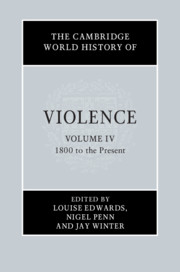Book contents
- The Cambridge World History of Violence
- The Cambridge History of Violence
- The Cambridge World History of Violence
- Copyright page
- Contents
- Figures and Maps
- Contributors to Volume IV
- Introduction to Volume IV
- Part I Race, Religion and Nationalism
- Part II Intimate and Gendered Violence
- 7 A Global History of Sexual Violence
- 8 Sexual Violence against Children: A Global Perspective
- 9 Homicide in a Global Perspective: Between Marginalisation and Resurgence
- 10 Violence and Sport, 1800–2000
- Part III Warfare, Colonialism and Empire in the Modern World
- Part IV The State, Revolution and Social Change
- Part V Representations and Constructions of Violence
- Index
- References
7 - A Global History of Sexual Violence
from Part II - Intimate and Gendered Violence
Published online by Cambridge University Press: 13 March 2020
- The Cambridge World History of Violence
- The Cambridge History of Violence
- The Cambridge World History of Violence
- Copyright page
- Contents
- Figures and Maps
- Contributors to Volume IV
- Introduction to Volume IV
- Part I Race, Religion and Nationalism
- Part II Intimate and Gendered Violence
- 7 A Global History of Sexual Violence
- 8 Sexual Violence against Children: A Global Perspective
- 9 Homicide in a Global Perspective: Between Marginalisation and Resurgence
- 10 Violence and Sport, 1800–2000
- Part III Warfare, Colonialism and Empire in the Modern World
- Part IV The State, Revolution and Social Change
- Part V Representations and Constructions of Violence
- Index
- References
Summary
Sexually-violent practices and ideologies have varied dramatically over time and geographical region. There have also been important shifts in the weighting given to its two components: “sexual” and “violence”. Sexual violence is deeply rooted in specific political, economic, social, and cultural contexts. In exploring these issues on a global-scale the first question to ask is: who is entitled to label something as “sexually violent”? Despite the incredible personal suffering inflicted on victims of sexual assault, under-reporting is pervasive: victims routinely struggle to find words for their pain. Cognitive distortions about gender, sexuality, and violence have left legacies of abuse that are difficult to counter. Perpetrators of violence are often presented as victims and, in the context of mass rapes during wartime, international law has been sluggish in responding. The chapter concludes by evaluation the attempts by victims of sexual violence, feminists, politicians, lawmakers, police, and community activists to resist and eradicate sexual violence not only in their own societies but also globally. Rape thrives in situations of structural inequality. Although women act in sexually aggressive ways (and there is some evidence that the proportion of female aggressors is increasing), in the final analysis, political attempts to reduce and finally eliminate sexual aggression must start with the main perpetrators. Eradicating rape requires a radically different conception of agency and masculinity.
Keywords
- Type
- Chapter
- Information
- The Cambridge World History of Violence , pp. 147 - 167Publisher: Cambridge University PressPrint publication year: 2020
References
Bibliographical Essay
- 1
- Cited by

